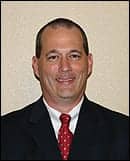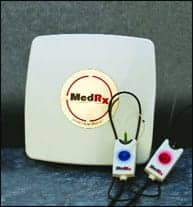
|
| C. Jason Brown |
The Hearing Review recently had the opportunity to meet C. Jason Brown, vice president of sales and marketing for Decos Audiology USA, and ask him a few questions about the Decos audiometer.
HR: Can you give us some history about Decos Technology?
Brown: Decos Technology is a 23-year-old software company that started in The Netherlands … Our system has been actively marketed for a decade in and around The Netherlands, and we have achieved a staggering 93% market share in the clinical audiometer market there! We are very proud of our success and of our Decos audiometer, so we decided to take this state-of-the-art system to the global market. We now have systems in place in over 10 countries all across the world including the United States, England, Belgium, Germany, and India, and we are actively expanding into other countries as we speak.
HR: So what are the unique features of the audiometer?
Brown: Decos Audiology is completely software-based. In fact, it is the only system of its kind in existence. The only external component to our system is a small distribution box called an AudioNigma® that allows for the use of seven transducers without having to “move plugs.” Because it is a completely software-based system, the Decos audiometer has unlimited flexibility and customization capability.
For example, we can use any sound you can imagine as stimulus or masking … all we need is for it to be in a digital format and we can handle the rest. We regularly design custom testing modules in support of university research projects, make programming and work-flow adjustments to accommodate individual customer needs, and customize print-out reports to match the customer’s current report structure. Literally anything a clinician may want to do that involves sound-based testing can be done.
HR: It sounds a bit complex. Is it?
Brown: No, not at all. We designed our system on a modular platform to make sure that, if someone only wants to conduct a basic audiogram, it can be done quickly and easily. We can basically adjust the complexity of our system to meet the needs of each facility. That is why we offer different packages designed to address different segments of the audiological market. We have customers ranging from rural hearing aid dispensers all the way up to research audiologists who are working on testing platforms for the next generation of medical advancements.
HR: What about electronic medical records and management?
Brown: As a software company, we are actually more concerned about managing the test data both before and after the test. For example, many facilities use some sort of EMR/EHR system to manage patient data and medical records. As the world continues to move toward a “paperless environment,” medical professionals are more and more pressured to abandon paper audiograms. The audiology world has been painfully underserviced in this regard until now. Decos Audiology can actually “import” all of a patient’s demographic data directly from the EMR/EHR system, thereby saving around 5 minutes per test and further eliminating the need to maintain paper patient files. Then, once the test is complete, we can “export” the test data directly back into that person’s EMR/EHR profile.
We actually design a custom interface between our audiometer and the facility’s EMR/EHR system. So, when we export the information, it goes as “pure data” that can be used for any future purpose. For example, if you own ABC facility, and one of your hearing aid manufacturers designs a new device to specifically treat patients with a hearing threshold above 50 dB at 2,000 Hz, it would clearly be a benefit to be able to immediately query your entire patient database for people with that exact situation. With almost any other audiometer, the research to create that query would be a nightmare. However, with the Decos system, it would take around 2 minutes, and you immediately have your list. So, this system can actually be used to create a revenue stream for the facility.
As another example, we have a number of facilities that have historically “outsourced” their tinnitus patients to a specialist. With the Decos audiometer, our Tinnitus Module makes it easy to calculate all the coordinates necessary to calibrate a tinnitus device. One of our customers actually purchased our system based solely on that increased revenue stream … She said that she couldn’t afford “not to have it in my practice!”
HR: Tell us about some of the modules that are available.
Brown: The Tone and Speech Modules would be simple and obvious, except that they do more than any other single audiometer. The Tone Audiometer Module offers a number of unique abilities. For example:
- We can support testing down to 1/24th of an octave to specifically locate a patient’s dead zones;
- For pediatric testing, we offer calibrated “sounds” to use in lieu of tones that are accurate to one-third of a bandwidth;
- Ipsilateral masking is available in either synchronized or manual modes; and
- There is fully customizable workflow
In our Speech Audiometer Module, we actually load all of the customer’s existing disks and “index” them so that the audiologist and patient control the time between words rather than them being controlled by the recording … so the test is quick for people with normal hearing, and slower for patients who need more time.
The two modules that really get the most attention are the Video VRA module and the Audio Player Module. The Video VRA module is basically a full tone audiometer with live speech capability that has an integrated VRA system. This allows not only for “one-stop” testing for pediatric settings, but it also creates unbelievable patient customization! We can actually allow a facility to use pictures or videos from the child’s own environment as a reward (eg, a video of mom clapping, or the family dog barking). We can also use a variety of popular cartoon characters—whatever each child wants or likes. As long as the customer can give us the information in a digital format, we can use it—subject, of course, to applicable copyright laws!
Our Audio Player Module is frankly the neatest part of our entire system. Many people in our industry ask, “Is it a true two-channel audiometer?” Our program team gets sort of tickled when we ask them that. Our Decos Audio Player system is actually like a 14-channel audiometer where we can send any digital sound to any transducer at the same time—or multiple sounds to the same transducer. One of our customers recently challenged us to generate a stimulus of 2,000 Hz and a 250 Hz narrow-band noise at the same time, and then in the same ear. When I showed her how that was not only possible, but quite easy in the Audio Player Module, she smiled and said that she had never seen an audiometer that could do anything close to that. She admitted later that there was no clinical use for that function; she was just testing us. But we were happy to pass the test.
Some of our other modules include a 180° or 360° soundfield ark for calibration of hearing aids and other research projects, a VCV and CVC test used for sound discrimination, a Tymp Import module that allows you to electronically import all of your patient’s impedance readings into their EMR/EHR the same as our audiogram data, Tone Decay, ABLB, High Frequency (from 8k to 20k at 250 Hz increments), and QuickSIN self-scoring module.
HR: What do you see as limitations in the system?
Brown: Some people ask us if our system actually has any limitations. After some reflection, the only limitation we could come up with was that it can actually do too much! The transition from a manual system to our software-based system can be a little intimidating. To address that, we normally encourage people to take a 2-week “test-drive” of our system in their main testing booth. After using the system for that period of time, people normally don’t want to give it back. It just takes some time to get used to it—sort of like getting a new car. At first, it can be hard to even remember how to turn on the wipers, but after the first 100 miles, it begins to feel very comfortable and easy.
HR: Where do you envision Decos Audiology in the United States 5 years from now?
Brown: Within the next 5 years, we plan to create, develop, and constantly improve the world’s best audiometer system based on direct feedback from our customer base as to what they want from their audiometer. And we’re already doing that. So, I guess in 5 years, we will be doing a whole lot more of the same things that have made us the world’s best audiometer system!
HR: Where can professionals get more information about Decos?
Brown: Our distributors include Specialty Instruments, Inter-Med Technologies, Biocoustics Instruments, Acousti-cal, Audiometrics, Audio Electronics, and Audio-Med. We are adding distributors as we can; however, as a matter of corporate policy, we are very particular about whom we allow to represent our products. We believe that the service level we provide after the sale is our best selling point, and we require that our distributors abide by that same philosophy.
For more information, contact C. Jason Brown at , (281) 330-7669; or visit www.decosaudiology.com.





